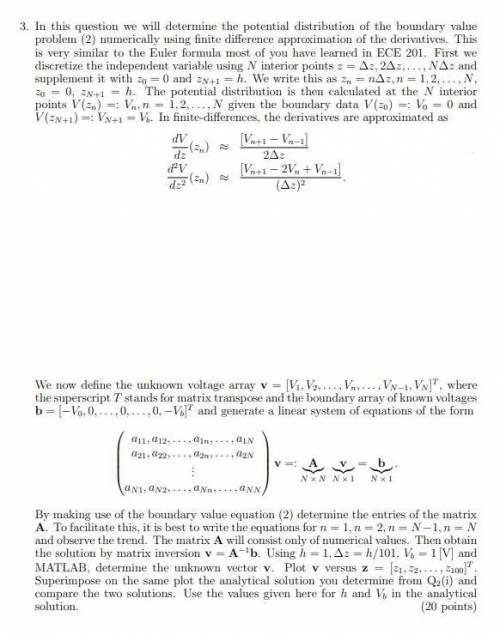
Engineering, 23.02.2022 15:10 chelsey54
In this question we will determine the potential distribution of the boundary value
problem (2) numerically using finite difference approximation of the derivatives. This
is very similar to the Euler formula most of you have learned in ECE 201. First we
discretize the independent variable using N interior points z = ∆z, 2∆z, . . . , N∆z and
supplement it with z0 = 0 and zN+1 = h. We write this as zn = n∆z, n = 1, 2, . . . , N,
z0 = 0, zN+1 = h. The potential distribution is then calculated at the N interior
points V (zn) =: Vn, n = 1, 2, . . . , N given the boundary data V (z0) =: V0 = 0 and
V (zN+1) =: VN+1 = Vb. In finite-differences, the derivatives are approximated as
dV
dz (zn) ≈
[Vn+1 − Vn−1]
2∆z
(3)
d
2V
dz2
(zn) ≈
[Vn+1 − 2Vn + Vn−1]
(∆z)
2
. (4)
We now define the unknown voltage array v = [V1, V2, . . . , Vn, . . . , VN−1, VN ]
T
, where
the superscript T stands for matrix transpose and the boundary array of known voltages
b = [−V0, 0, . . . , 0, . . . , 0, −Vb]
T and generate a linear system of equations of the form
a11, a12, . . . , a1n, . . . , a1N
a21, a22, . . . , a2n, . . . , a2N
.
.
.
aN1, aN2, . . . , aNn, . . . , aNN
v =:
|{z}
A
N × N
v
|{z}
N × 1
= b
|{z}
N × 1
. (5)
By making use of the boundary value equation (2) determine the entries of the matrix
A. To facilitate this, it is best to write the equations for n = 1, n = 2, n = N −1, n = N
and observe the trend. The matrix A will consist only of numerical values. Then obtain
the solution by matrix inversion v = A−1b. Using h = 1, ∆z = h/101, Vb = 1 [V] and
MATLAB, determine the unknown vector v. Plot v versus z = [z1, z2, . . . , z100]
T
.
Superimpose on the same plot the analytical solution you determine from Q2(i) and
compare the two solutions. Use the values given here for h and Vb in the analytical
solution.


Answers: 2


Other questions on the subject: Engineering

Engineering, 04.07.2019 18:10, lillygrl100
For the closed feedwater heater below, feedwater enters state 3 at a pressure of 2000 psia and temperature of 420 °f at a rate of ix10 ibhr. the feedwat extracted steam enters state 1 at a pressure of 1000 psia and enthalpy of 1500 btu/lbm. the extracted er leaves at an enthalpy of 528.7 btu/lbm steam leaves as a saturated liquid. (16) a) determine the mass flow rate of the extraction steam used to heat the feedwater (10) b) determine the terminal temperature difference of the closed feedwater heater
Answers: 3

Engineering, 04.07.2019 18:10, leomessifanboy678
The filament of an incandescent lamp has a temperature of 2000k. calculate the fraction of radiation emitted in the visible light band if the filament is approximated as blackbody
Answers: 2

Engineering, 04.07.2019 18:10, QueenLife4869
Awall of 0.5m thickness is to be constructed from a material which has average thermal conductivity of 1.4 w/mk. the wall is to be insulated with a material having an average thermal conductivity of 0.35 w/mk so that heat loss per square meter shall not exceed 1450 w. assume inner wall surface temperature of 1200°c and outer surface temperature of the insulation to be 15°c. calculate the thickness of insulation required.
Answers: 3

Engineering, 04.07.2019 19:10, pjgolden04
How to increase the thermal officiency of an ideal simple rankino cycle? among these methods, which one is the best and why?
Answers: 2
You know the right answer?
In this question we will determine the potential distribution of the boundary value
problem (2) nu...
Questions in other subjects:

Mathematics, 03.07.2019 18:30




History, 03.07.2019 18:30


History, 03.07.2019 18:30


Arts, 03.07.2019 18:30

History, 03.07.2019 18:30



